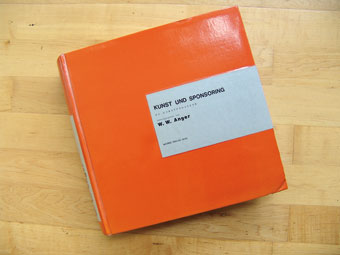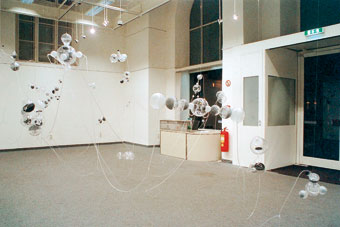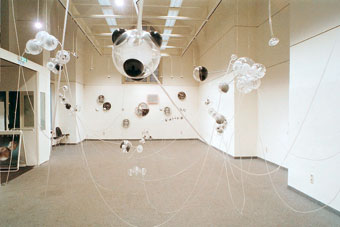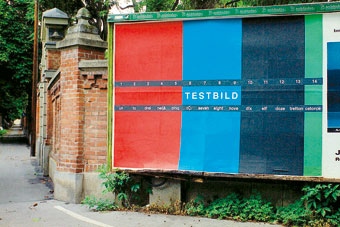|
|
| ´03 | ´02 | ´01 | ´00 | ´99 | ´98 | ´97 | ´96 | ´95 | ´94 | ´93 | ´92 | ´91 | ´90 | ´89 | ´88 | ´87 | ´86 | pre ´85 |
 |
Art and Sponsoring Photo album as an art object for the album 00 exhibition at the Galerie Cult in Vienna. Photo album: 30 x 30 cm; photos and texts 10 x 17.5 cm each. album 00 | Galerie Cult, Vienna | November 15, 2000 – January 27, 2001 | exhibition participation. |
Kunst und Sponsoring Fotoalbum als Kunstobjekt für die Ausstellung album 00 in der Galerie Cult in Wien. Fotoalbum: 30 x 30 cm; Fotos und Texte je 10 x 17,5 cm. album 00 | Galerie Cult, Wien | 15. November 2000 bis 27. Jänner 2001 | Ausstellungsbeteiligung. album 00 | Ausstellungsraum Büchsenhausen, Innsbruck | 6. April bis 12. Mai 2001 | Ausstellungsbeteiligung. |
  |
Subsystem/Cell Division #1–7/Anorganic Matter Four-part room and wall installation consisting of three groups of objects. Subsystem: twenty-part; PVC spheres, plastic tubes, model figures, threaded rods, paint, nylon thread, nuts. Cell Division #1–7: seven-part, diameter between 9 and 20 cm; plaster, PVC spheres, paint, screws, nylon threads. Anorganic Matter: seven-part wall installation consisting of one large (69 cm diameter) and five smaller disks (39 cm diameter each) and a text panel. Materials: acrylic glass, felt pen, paint. Total size: variable. Subsystem | Ecksaal Joanneum, Graz | March 28 – April 13, 2002 | solo exhibition. |
Subsystem/ Zellteilung #1–7/ Anorganische Materie Vielteilige Raum- und Wandinstallation, bestehend aus drei Objektgruppen. Subsystem: zwanzigteilig; PVC-Kugeln, Plastikschläuche, Modellfiguren, Gewindestangen, Lack, Nylonschnüre, Muttern. Zellteilung #1–7: siebenteilig, Durchmesser jeweils zwischen 9 und 20 cm; Gips, PVC-Kugeln, Lack, Schrauben, Nylonschnüre. Anorganische Materie: siebenteilige Wandinstallation aus einer großen (Durchmesser 69 cm) und fünf kleineren Scheiben (Durchmesser je 39 cm) sowie einer Texttafel. Materialien: Acrylglas, Filzstift, Lack. Gesamtmaß: variabel. Subsystem | Ecksaal Joanneum, Graz | 28. März bis 13. April 2002 | Einzelausstellung. |
 |
Test Card Poster action in public space. Four bars of color, each associated with a particular Austrian political party – red, blue, black, green – divide the poster vertically. The blue bar bears the caption “TESTBILD” (test card) in white letters. Above this word is a black horizontal bar with a negative inscription of numbers (from 1 to 14); below the capital letters is a bar with the numbers written in words in various languages. Time Art | poster action of Gruppe 77 in public space, Graz | July 2000 | exhibition participation | art critics’ prize. |
Testbild Plakataktion im öffentlichen Raum. Vier den politischen Parteien Österreich assoziierte Farbbahnen – rot, blau, schwarz, grün – teilen das Plakat in vertikaler Richtung. Der blaue Streifen trägt in weiße Lettern die Aufschrift „TESTBILD“. Oberhalb dieses Begriffs ist ein schwarzer Horizontalstreifen mit der negativen Inschrift von Zahlen (von 1 bis 14) angebracht, unterhalb der Versalien ein Streifen, der die dazugehörigen ausgeschriebenen Zahlen in verschiedenen Sprachen trägt. Kunst auf Zeit | Plakataktion der Gruppe 77 im öffentlichen Raum, Graz | Juli 2000 | Ausstellungsbeteiligung | Preis der KunstkritikerInnen. |